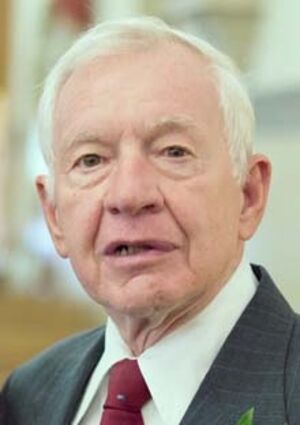Lee Ostdiek to join Journalism Hall of Fame
Lawrence native will join Journalism Hall of Fame
July 14, 2022
A retired Blue Hill newspaper publisher, Leland Ostdiek will be one of six inductees to join the Nebraska Journalism Hall of Fame during ceremonies to be held Saturday, Oct. 22, at The Graduate Hotel in Lincoln.
The other five 2022 inductees are Tim Anderson, associate professor emeritus, UNL College of Journalism and Mass Communications; John Bender, associate dean and journalism professor, UNL College of Journalism and Mass Communications; Russ and Lori Pankonin, former co-publishers of the Imperial Republican, Grant Tribune-Sentinel and Wauneta Breeze; and Tom Southard (posthumously), longtime sports writer for the Kimball Western Nebraska Observer. Russ and Lori Pankonin are the first husband and wife team to be inducted into the Nebraska Journalism Hall of Fame.
The Nebraska Journalism Hall of Fame is sponsored by the Nebraska Press Association and the University of Nebraska-Lincoln College of Journalism and Mass Communications. This award honors those who have made significant contributions to journalism in their communities, the state, or the nation. Since the first Nebraska Journalism Hall of Fame ceremony in 1975, 118 honorees have been inducted.
Today central printing plants are the norm for Nebraska newspapers. Daily newspapers like the Lincoln Journal-Star are printed outside of their home county. Many newspapers are even printed outside of Nebraska. It once wasn't possible for a Nebraska newspaper to maintain legal status and be printed in another county. Leland Ostdiek and his family cleared the way for what is now a common practice. Their plan to print outside the county was challenged in the courts and the case went all the way to the Nebraska Supreme Court.
They were determined. They didn't give up and fought the issue until it was settled. Thanks to the Ostdieks, it is now possible for Nebraska newspapers to be printed in central plants.
Lee is now the retired editor of the Blue Hill Leader. Most of his newspaper career was with the Blue Hill Leader. However, his first introduction to the newspaper business came at the age of 8 when his family became involved with the Lawrence Locomotive. He experienced the evolution of newspaper production and writing from lead type and letterpress printing, to offset printing, phototypesetting machines, and finally to desktop publishing. As a child, he used handset type to help produce his family's newspaper, The Lawrence Locomotive. One of 12 children, he worked his way through college with his knowledge of printing. He worked in printing plants in Lincoln and at newspapers in Falls City, Superior and McCook.
Other than being an expert with a stick and handset type, he mastered the Linotype and a wide range of printing presses. With the switch to offset printing, he mastered the operation of his press with a manual written in German. With that press in Blue Hill, he printed the Blue Hill Leader, the Lawrence Locomotive and the Nelson Gazette newspapers and did commercial printing.
At the request of a number of businessmen in the neighboring town of Clay Center, he was instrumental in starting a newspaper to serve that community. While the type for the Clay Center Leader was set in Clay Center, the heavy lead type was taken into Nuckolls County and used to print the paper on a press located in the Lawrence Locomotive plant. At that time, his parents, Hubert and Louise Ostdiek, operated the Locomotive.

As the skilled craftsmen of the printing trade reached retirement age, and the technology of offset printing came into place in the 1960s and 1970s, Mr. Ostdiek greeted the new age with enthusiasm. He helped usher in the new technology in South Central Nebraska. Mr. Ostdiek bridged the gap from handset type and imaginary type lice to the computer virus and barcoded mail.

Lee Ostdiek
The lives of small town editors are necessarily intertwined closely with their communities, however, Mr. Ostdiek was more than a mere witness to the world around him. From his first days in Blue Hill, he has served the community on various committees and governing boards. He has been active in his church and served his community in countless ways that would tax the best and brightest of any generation. While his contributions within Blue Hill have been many, he has also benefited South Central Nebraska in a larger way with his service on several governing boards. When Nebraska implemented the natural resource district concept of governing environmental assets, he served on the board of the Little Blue Natural Resource District for eight years. In the early 1990s, when opposition to the idea of building a low-level nuclear waste storage facility in South Central Nebraska was so intense it was nearly impossible to find people to serve on the committee evaluating the pros and cons of the project, Lee accepted an appointment and helped to give the level-headed advice needed to guide the committee through its ordeal.
He has served his church in Blue Hill and has contributed to a larger area through his leadership in the Knights of Columbus and in the Criseal movement. He has served his profession with stints as a director and president of the Nebraska Press Association and Nebraska Press Advertising Service.

Lee and his wife, Joyce, purchased the Blue Hill Leader in 1960. He served as the newspaper's editor for more than 50 yeas. They raised nine children and trained them to be contributing members of society.





Reader Comments(0)